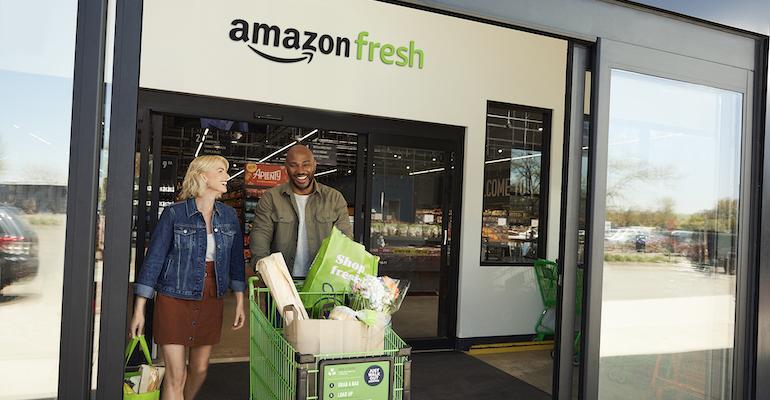A forum for contributed pieces from industry thought leaders, retailers, wholesalers and manufacturers. The views expressed are those of the authors.
12 minutes at Groceryshop, and 12 things you might not know12 minutes at Groceryshop, and 12 things you might not know
‘Grocery Giants’ keep up the pressure on regional and local supermarket operators

Scott Moses is a managing director and head of grocery, pharmacy and restaurants investment banking at Solomon Partners, a New York-based M&A investment banking advisory firm. He writes a quarterly column for Supermarket News about sector trends, including operating, valuation and strategic dynamics.
 Last week, I was invited to speak at the Groceryshop conference in Las Vegas. I was asked to provide some insights on the economy and competitive landscape in our industry. In the 12 minutes I was allotted, I shared “12 Things You Might Not Know.” I’ve been encouraged to share the transcript, which is below, slightly edited, along with the presentation itself (click here).
Last week, I was invited to speak at the Groceryshop conference in Las Vegas. I was asked to provide some insights on the economy and competitive landscape in our industry. In the 12 minutes I was allotted, I shared “12 Things You Might Not Know.” I’ve been encouraged to share the transcript, which is below, slightly edited, along with the presentation itself (click here).
Good afternoon, everyone. So I’ve got 12 minutes. Reminds me of Springsteen’s Super Bowl halftime show a few years ago — 12 minutes to rock the audience. Well, I’m no rock star, at least not since I cut my really long COVID hair off my shoulders, after a year. They asked me not to tell you things you already know. So, in our 12 minutes together, I’m going to share 12 things you might not know about the economy and our strategic landscape.
A little background first. I’ve been an M&A adviser for over 20 years. I advise grocers and food tech companies, like Boxed, which we sold last year; Cardenas, the specialty Latino grocer we sold this summer for KKR to Apollo; and Imperfect Foods, which we’re selling to Misfits. It’s really good to be back here, after three years away.
No. 1
The first thing you might not know, unless you know me, is in the spring of 2020, we didn’t leave our apartment building in New York City for 10 weeks. That’s 70 days. Sirens all day and night, mobile morgues all around the city. It was scary, and it was surreal. Here’s the view down Third Avenue from my roof in April of 2020, a month into the lockdown, in the middle of the day. No cars, empty streets.
Ask yourself: How would you have fed your family that spring without your local grocers?
I don’t know about you, but I’m not much of a farmer. I’m not much of a gardener. But I did see firsthand the extraordinary work my clients around the country did to feed and help sustain their communities. There’s no overstating it: This industry really matters. So let’s talk about what’s happening to it.
Here are the key themes for our 12 minutes. It’s like a business school case study: macroeconomics (demand, price, inflation), microeconomics (competition, particularly from the nontraditional “Grocery Giants” like Amazon, Walmart, Target, Costco, Aldi and Dollar General), corporate finance (cost of capital for investment). All of this in a very fragmented sector.
No. 2
Macroeconomics. You probably know food inflation didn’t start with Ukraine. We had COVID supply-chain and energy challenges long before the invasion on Feb 24. Food inflation was 8.6% that month. You might not know there are 11 million jobs open and 6 million job seekers, a 5 million worker gap. Why?
First, we’ve lost hundreds of thousands of working-age Americans to COVID. You might not know that continued low labor force participation implies 2.5 million fewer workers than 2019.
You might not know that we’ve had a lot less immigration from 2017 to 2021. Irrespective of your politics — i.e. your views of taxes, social issues, climate change or our place in the world — more immigration could really help close the gap, alleviate some labor inflation and help lower prices. That’s just math.

No. 3
Microeconomics. You all know nontraditional Grocery Giants sell lots of groceries. You might not know the Giants now comprise the majority of American grocery sales.
No. 4
You might not know that 10 of the top 15 American grocers are not traditional supermarkets. There’s Amazon, No. 5 and growing fast. We’ll talk more about them shortly.
No. 5
You might not know that, in the last decade, there are over 12,000 more dollar store grocers. And they are absolutely, undeniably grocers, particularly in an inflationary trade-down environment. Dollar General’s actually planning another 16,000 new stores in the next decade — to 34,000 — well more than the 26,000 supermarkets today, down from 27,000 a decade ago.
No. 6
You may know that nontraditionals are now the “primary shop” for lots of people. You might not know that it’s 61% of Americans, up from less than 20% 20 years ago, now shopping at five banners and four channels per week.
No. 7
Corporate finance. You probably know that cost of capital is a proxy for CAC (customer acquisition cost) and customer retention. You might not know that, statistically, 60% of credit rating is scale. Look at our sector’s public operators — a clear relationship between scale and rating. Here’s how it works: bigger sales, better rating, cheaper debt, more investment.
There’s a robust “investment arms race” among the Grocery Giants for the “families of the future,” particularly online. You can see the largest online grocers are all Giants.
No. 8
You probably know Amazon is a trillion-dollar company (actually used to be over $2 trillion).You might not know it’s worth more than all other public grocers combined. That’s 3x Walmart, 30x Kroger, 65x Albertsons and greater than 650x Ingles, which generates $5 billion in annual revenue and has a $2 billion market cap. On an absolute basis, Ingles is a big company; on a relative basis, in this sector, it’s tiny.
You might not know that Amazon is AA credit and borrows cheaper than most countries.
You might not know their MGM purchase price, at $8.5 billion, was just 57 basis points of their $1.5 trillion market cap at the time. That’s 0.57% — doesn’t even move the needle. Now they have “James Bond” and “Rocky” movies to join “Mrs. Maisel,” strengthening their Prime subscription retention, which at $139 times 175 million members nets them $24 billion in cash each year, before they even sell anything, plus over $30 billion from ad revenue. All of this helps finance more investments in price, wages, marketing (think about all those Amazon commercials you’re seeing on TV), more tech advancements and growth.
It’s really tough for smaller grocers to keep up. Maybe that’s why Amazon’s market cap has grown 2x more during COVID than everyone else combined.
No. 9
We all know that Amazon’s growth has led to numerous bankruptcies and store closures. You might not know that grocery margins were 75% higher 20 years ago than before COVID. Most regional grocers lost 20% to 40% of their EBITDA in the five years before COVID. Since then, the Grocery Giants’ EBITDA growth — particularly Amazon — has been extraordinary.
No. 10
M&A in a highly fragmented sector. You probably know many large grocers were built by mergers and some private-equity firms have done extraordinarily well investing in and improving grocers with scale. You might not know that the sector today looks like department stores 30 years ago: fragmented, growing Giants and lots of discount, specialty and online competition. Long-term viability for smaller traditional operators likely requires the same kind of consolidation we’ve seen with the department store chains that have survived.
Now, you might say I’m biased; I’m in the M&A business. But that fact doesn’t make any of these other facts any less true. This is not fake news; it’s real grocery math.

No. 11
You hopefully now know some more about the Grocery Giants and Amazon’s impact on grocery. You might not know that the Federal Trade Commission knows it, too. Chair Lina Khan predicted it five years ago in this New York Times op-ed (see following excerpt) after Amazon’s acquisition of Whole Foods was announced. I think it’s worth reading out loud:
“Buying Whole Foods will enable Amazon to leverage and amplify the extraordinary power it enjoys in online markets and delivery, making an even greater share of commerce part of its fief. … By bundling services and integrating grocery stores into its logistics network, the company will be able to shut out or disfavor rival grocers.” Prescient.
The good news is the FTC staff increasingly seems to understand the urgency, too, because as a practical matter, every day they delay a proposed merger of two smaller grocers trying to keep up and build the scale they need to survive, they’re effectively putting their thumb on the scale in favor of the Grocery Giants. That may not be their intention, but it is the result. That’s not fair, and it’s not good for the country.
No. 12
Here’s why: We all know lots of people who’ve worked in grocery stores. You might not know that millions of Americans and their families rely on supermarket jobs. The stores have been pillars of thousands of American communities for generations, helping us feed our families in crisis after crisis. They’re a critical component of the fabric of this country, and we need to protect them.
Last thought, the encore. Sorry, it won’t be “Born To Run” or “Thunder Road” for the Springsteen fans out there.
Last December, I wrote my quarterly column for Supermarket News, called “A Grocery Christmas Carol: The Ghost of Supermarkets’ Future.” I wrote how the Grocery Giants are using their scale and low cost of capital to grab significant share (“Grocery Present”), and the real risk that many local operators — who have sustained us during this crisis — might not be there for us in the next one (the “Ghost of Supermarkets’ Future”).
The department store sector is the logical extension of the “Grocery Present.” It’s a cautionary tale. Thousands of dark stores, no longer serving their communities or offering great first jobs and careers for millions of young people. Just Amazon, Walmart, Costco, Aldi and Dollar General stores in town, with Amazon and Walmart fulfillment centers on the outskirts. Not exactly the most engaging job for young people, you know, before they get automated away.
That version of America does not work for me. And it shouldn’t work for you either. Period, full stop.
My job may be to maximize shareholder value, but I keep score on how many grocery stores and jobs our transactions save or strengthen. What I love about Groceryshop is it spotlights technology that helps level the playing field for smaller grocers and enable them to continue serving our communities.
I hope these “12 Minutes” help motivate all of you tech leaders out there to keep innovating, keep helping our regional grocers protect what, to me, is an undeniably better version of America than we would be without them. Remember: How would you have fed your family? Thank you very much.
About the Author
You May Also Like





.webp?width=300&auto=webp&quality=80&disable=upscale)
